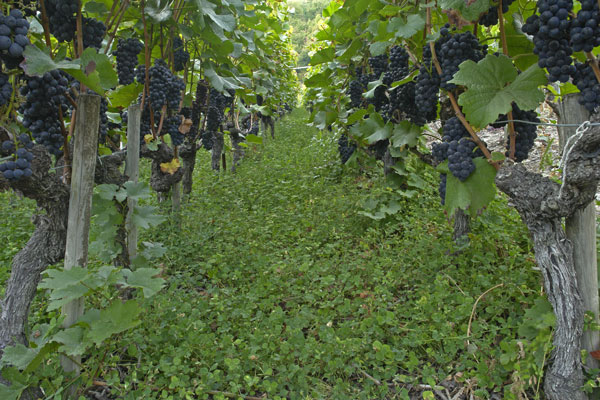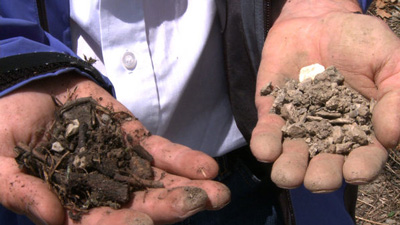Climate Farming – A Master Plan for Sustainable Agriculture
by Hans-Peter Schmidt
print version with citable page numbers
Perhaps the Earth’s soil can be best understood to be an infinite network of entities. It is comprised of innumerable small organisms, bounded minerals, water, roots and more or less decomposed plant materials. Almost 90% of all organisms of our planet live in soil and make sure through interactions the perpetuation of the life processes. Highly complex, well-coordinated symbioses between microbes and plant roots guarantee the virtually infinite flow of self-contained nutrient cycles by which almost no wastes are produced.

Plants, through their roots and exudates (detached substances from the roots), are in immediate functional connection with the network of soil life. For example, in a healthy soil, the exudates of a full-grown vine provide up to 10 billion microorganisms with carbohydrates in exchange for nutrients, which the vines could otherwise not take up. The extremely diverse life network in the soil assures not only the provision of nutrition and health of plants but also the preservation and stability of the soil. It is only when the high biological activity of the soil is warranted and the elemental cycles are closed that the soil humus content can increase and thus allowing the binding of atmospheric carbon. In order to efficiently back up the biodiversity of the agricultural soil, there are several fundamental requirements in agricultural production which have to be met:
1. Abandonment of the use of mineral fertilisers, liquid and semi-liquid manures and concentrate fertilisers. Dung should be composted before use for production.
2. Abandonment of herbicides.
3. Gradual reduction of the use of pesticides and long-term conversion to biologically active plant protectors (composts and plant extracts).
4. Fertilisation with active composts and biochar-compost mixtures.
5. Substitution of heavy farm equipment with light, well thought-out machines. No deep-ground cultivation.
6. Construction of permanent, species-rich canopies as cover crops. Adherence to reasonable crop rotation and mixed cultures.
Charter for Biodiversity in Agriculture
High plant diversity through mixed cultures, cover crops and structural measures lead to higher diversities of bacteria, fungi, insects, and other animals, which, in turn, decreases pest infestation and, therefore, bring about a generally stable agricultural ecosystem.

Through wise structural crop growing of secondary and mixed cultures (e.g. tomatoes and rye between vines) it is possible that food production becomes excellently complemented by boosting of biodiversity and cultivation of bioenergy crops (e.g. fast-growing tree rows and grain fields). The planting of bioenergy crops between the primary cultures enable the production of combustible fuel and energy products as well as biochar and compost, which in turn are advantageous to soil activities and climate neutrality.
Without significant losses on productivity and by equal boosting of biodiversity, climate farms can produce energy and store atmospheric carbon into their soils aside from cultivating their primary cultures. Farmers would also incur less economic risks with such diversification of an array of different agricultural products. Through climate farming, elemental cycles are closed and the agricultural ecosystem is stabilised via biodiversification . Instead of favouring climate change and species extinction, agriculture will help to sustainably secure climate and life, landscape and the prosperity of the society.
The concept of climate farming is initially based on an all-embracing promotion of biodiversity within agricultural production. To support these processes, the Delinat Institute set up a Charter for Biodiversity, which forms the basic principle for the production guidelines of more than 80 wine-growers with about 2000 ha in the whole of Europe. A similar charter is also being propagated among fruit growers. The ten point charter ranges from the reactivation of soils through composts and species-rich cover crops, planting of hedges and trees for vertical diversity until settlement of wild bees and measures for the preservation of genetic diversity within the primary culture.
Climate Faming through Biochar
High agricultural diversity together with the resulting humus production can significantly reduce agriculture’s contribution to global warming that counts actually about 15%. However, a sustainably climate-positive result can only be achieved if carbon can be extracted from the carbon cycle and be stored permanently in the soil. Without industrialisation, which is based on burning fossil fuels, a closed carbon cycle on humus-rich agricultural soils would naturally be enough. However, with the present CO2 concentration in the atmosphere, it is necessary to actively reduce and store carbon in order to impede and ultimately reverse climate change. Since plants are most efficient in taking up atmospheric carbon, it stands to reason that agriculture takes advantage of this natural process to become carbon harvesters and sequesters through an ingenious processing of this plant carbon.

The technology needed for this process is known and available. If biomass (basically carbon molecules), with the exclusion of oxygen is heated to at least 400 degrees Celsius, the long chains of carbon molecules break up. Beside an energy-rich gas, biochar is produced in this process, which is made up of pure and thousand-year stable carbon.
The production and application of this biochar have a key role to play in the realisation of the climate farming concept. Biochar can be obtained from residues of agricultural production, from bioenergy crops in mixed cultures and ecological compensation areas as well as from lop and other biological wastes of the municipality. In small local pyrolysis plants such as, for example, the 500-KW-Pyreg unit (2), up to 1000 tons of biomasses can be pyrolysed annually, which quantitatively corresponds to that of a small rural commune’s biomass accumulation. While the produced waste heat is utilisable for drying up biomass, generation of electricity or heating up of buildings, the biochar can be used as a highly potent soil conditioner in agriculture. Aside from the many positive qualities that biochar as soil conditioner has, carbon is stored in the soils and is therefore permanently taken out of the atmosphere.
Biochar in Research
The decisive approach in the use of biochar is not just to sequester it at industrial level but to multiply its beneficial aspects when using it to increase soil fertility.
Research has demonstrated the following advantages of biochar for soil culture:
- considerable increase of water storage capacity
- increment in growth of soil bacteria in niches of highly porous coal of protected habitats, which is conducive for plant nutrient cycles
- growth/increase of root mycorrhiza for better mineral uptake
- adsorption of toxic ground molecules such as NOx, Cu, heavy metals and its consequent effective groundwater protection
- better ground aeration and consequently significant reduction of methane and nitrous oxide emissions
- enhancement of oxygen fixation
In the beginning of 2009, several Swiss and German institutes, researchers and companies founded the open Biochar Research Network (4) in order to investigate the agronomic effects and other possible applications of biochar comprehensively. Owing to extensive collaborations, all essential agricultural, biological, chemical, climate change and technical aspects of biochar use are to be investigated and for practical applications made utilisable in the coming years. The program ranges from analysis of elementary composition of biochar in connection with the raw material as well as features of pyrolysis processes and the effects on activation of soil until the probable influence on the aromatic quality of the grapes.
A View in the Future
Biochar is not the wonder weapon and certainly not “the only hope for mankind”, as James Lovelock recently described. However, since biochar offers a whole range of solutions to different main problems of our planet, it might really be the initial point of the transition of agriculture and the boundary of climate change. But it will only happen when biochar production and its use will be integrated in an agronomic, bioenergetic and ecologic master plan.
We would have reached one of our major goals when we finally have no more need for ecological compensation areas and nature reserves, in which nature can only survive if human access is prohibited. Afterall, high ecological quality and biodiversity have to reign on agricultural lands themselves meeting all the qualities expected of a highly species-rich nature park.
print version with citable page numbers
Green: Climate farming one-ups organic



Otto Burtscher
2009-10-18 14:42
Unsere Webseite ist schon lange nicht mehr aktuel. Es sieht jedoch so aus als wäre unser Betrieb nach Ihren Vorstellungen auf dem neuesten Stand, nur mit der Kohle ist das so ein Problem. Material ist vorhanden, doch wie mache ich Kohle daraus, ohne den Geldbeutel zu sehr zu strapatzieren?
MfG
Otto Burtscher
Greg Woods
2014-09-26 18:58
Hi Peter, have your neighbour and yourself been able to make any comparisons in yield and quality between the standard soils and the biochar treated soil.
If this has been done, it would be interesting to compare the profitability of each crop, i.e. how many extra bottles of wine did each hectare create, and was this of such a quality that you could attract a better price.
High Regards
Greg Woods
hps
2014-09-27 07:28
Sorry Greg, but we couldn't see any increase in yield nor in quality after 3 years. It's certainly not the final word as there have been other important factors that might have changed the outcome but for the moment nothing much positive to report. cheers, hp